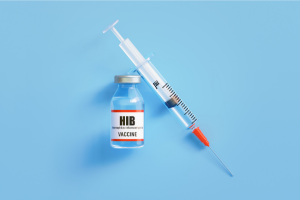Haemophilus Influenzae Type B is a bacteria that can cause severe infections in children, including meningitis, pneumonia, epiglottitis, septic arthritis, cellulitis, osteomyelitis, pericarditis, and bacteremia or bacteria in the bloodstream. Haemophilus Influenzae Type B (HIB) occurs in infants and children younger than five years old.

SYMPTOMS:
The symptoms of Haemophilus Influenzae Type B (HIB) vary widely. The bacterium can affect any part of the body and cause disease. Symptoms can include:
- Fever
- Lethargy
- Irritability
- Cough
- Headache
- Joint pain
- Difficulty breathing
- Stupor
- Coma
- Shock
- Shock leading to death
CAUSES:
This is a bacterial illness from the bacterium Haemophilus Influenzae Type B.
CONTAGION:
The bacterium is contagious through respiratory transmission, and all exposed people should be treated prophylactically. The incubation period is unknown as people can carry the bacterium indefinitely without showing symptoms. Children under five years of age are at highest risk.
DIAGNOSIS:
A clinical suspicion of the illness by observance of the symptoms of the child helps to make the diagnosis. A blood, urine, spinal fluid, or joint fluid culture can be done to confirm the diagnosis.
TREATMENT:
Haemophilus Influenzae Type B (HIB) treatment consists of intravenous antibiotics for ten to fourteen days.
OUTCOME:
This illness can be severe. Even with prompt treatment, one out of every twenty children will die, and four out of twenty will be deaf, blind, or mentally disabled. Others will have small deficits in hearing, vision, and motor skills.
DISCUSSION:
Haemophilus Influenzae Type B can be a devastating illness. Early treatment is best, but many children cannot be saved even with an immediate diagnosis and prompt treatment. Meningitis, or infection of the brain’s lining, can lead to a quick death or long-term problems. The bacterium can invade any organ in the body and cause disease. Once diagnosed, intravenous antibiotics can be started. Family members should be treated prophylactically with an antibiotic called rifampin. Close contacts at school or daycare should be warned.
The only way to combat this illness is through vaccination. Before 1990, there were nearly 25,000 cases of Haemophilus Influenzae Type B, 15,000 cases of which were meningitis, and about 500 deaths a year. After years of using the vaccine, the rate has decreased to less than 1,300 cases of Haemophilus influenzae Type B (HIB), 100 cases of meningitis, and less than five deaths a year. The HIB vaccine is given at two, four, and six months of age, with a booster dose at fifteen months. Any child over fifteen months who has not received the vaccine will only need one dose. After the age of five years, the vaccine is not necessary. This vaccine has worked exceptionally well in helping to eradicate this illness quickly. There are no serious side effects to this vaccine.
ONE DOCTOR’S OPINION:
The vaccine for HIB has been incredible. In my professional career, I have gone from seeing HIB meningitis routinely to not seeing one case in over thirty years. HIB used to be the number one cause of meningitis. It’s almost unheard of, leaving pneumococcus and meningococcus as the two leading causes (pneumococcus decreasing due to that vaccine). The importance of this vaccine cannot be emphasized enough. No children should be left susceptible to this potentially fatal disease.
This blog was written by Dr. Michael Bornstein, who has 30 years of experience as a pediatrician.
Disclaimer: The contents of this article, including text and images, are for informational purposes only and do not constitute a medical service. Always seek the advice of a physician or other qualified health professional for medical advice, diagnosis, and treatment.


FOLLOW US